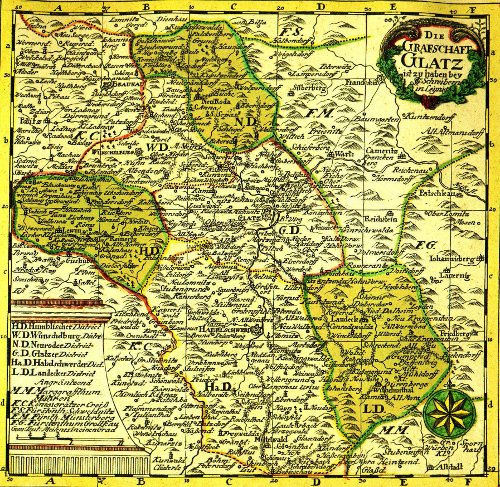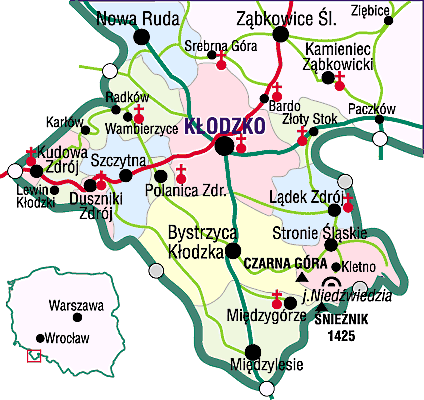{datsopic id=127 align=left} Prehistory – The area of present-day Kłodzko has been populated at least since the 1st century BC. There are several archaeological sites both in and around the town that indicate that there must have been a settlement located on the ancient Amber Road that conducted extensive trade relations with the Roman Empire.
Kingdom of Bohemia – The earliest mention of the town itself is in a 12th century chronicle by Cosmas of Prague. He mentions the town of Cladzco as belonging to Slavník, father of Adalbert of Prague, in 981. Initially in Bohemia, the town was also claimed by the Kingdom of Poland, which led to a series of conflicts which in turn devastated the city completely by the beginning of the 12th century. In 1114 Bohemian prince Soběslav (later duke Soběslav I) burnt the town to the ground, but he rebuilt it shortly afterwards. He also rebuilt and strengthened the castle located on a high rock overlooking the town. After the peace treaty of 1137, Duke Bolesław III Wrymouth of Poland ceded all claims to the land of Kłodzko to the Bohemian Principality (later Kingdom).
{datsopic id=114 align=right}The town was granted German city rights under Magdeburg Law between 1253 and 1278, though the exact date is unknown. In 1278 it was taken over by the Silesian duke Henry Probus (he claimed entire Bohemian kingdom after death of Ottokar II of Bohemia but failed). In 1290 it was sold to the Dukes of Świdnica and then, in 1301, it was sold to the Dukes of Ziębice. However, in 1334, Duke Boleslav II sold the town back to the Kingdom of Bohemia. The same year John of Luxemburg, King of Bohemia, relocated the town, which led to a period of fast growth. A city hall was built in 1341, and in the following year a brick factory was opened. From 1366, the town has been protected by a group of professional firemen. The town gained significant profits from its location on the ancient road through mountain passes in the Sudetes.
German Augustian monks were invited to the city and, in 1376, most streets were paved with stone setts. The Augustian abbey became one of the most important centres of culture in the region and, in 1399, the Florian Psalter (Psałterz Floriański), one of the earliest texts in the Polish language, was written there by a Polish Augustinian monk. In 1390 a Gothic stone bridge over the Młynówka, a local branch of Nysa Kłodzka river) was built by the local prince. During the Later Middle Ages, the population of the city gradually became Germanised, due to the German Ostsiedlung.
Glatz developed rapidly until the start of the Hussite Wars in the 15th century. The wars left the town depopulated by plagues, partially burnt, and demolished by several consecutive floods. In 1459 was elevated by king of Bohemia George of Poděbrady to County, but still remained integral part of Bohemia as “outer region”, and was not counted as part of Silesia. Before this elevation was integral part of the Kingdom of Bohemia.
{datsopic id=121 align=left}Habsburg Monarchy – In 1526 the Habsburgs were enthroned as the kings of Bohemia. Thus the County of Kladsko (hrabství Kladské) became a part of the Habsburg Monarchy; the local counts retained their powers and Bohemian kings (i.e. Habsburg emperors) ruled this land as suzerains. It was not until the 16th century that the local economy began to recover from the previous wars. In 1540 the sewer system was built. In 1549 the remaining streets were paved and the city hall was refurbished. Most of the houses surrounding the town square were rebuilt in a pure Renaissance style.
In 1617 the first census was organised in the County of Glatz. The city itself had approximately 1,300 houses and over 7,000 inhabitants. However, two years after the census took place the Thirty Years’ War started. Between 1619 and 1649 the fortress was besieged several times. Although the fortress was never captured, the city itself was largely destroyed. Over 900 out of 1,300 buildings were destroyed by fire and artillery and the population dropped by more than a half. After the war the Austrian authorities put an end to all local self-government, and the County of Glatz existed in name only. The city was gradually converted into a small garrison town attached to the ever-growing fortress.
{datsopic id=130 align=right}Kingdom of Prussia – annexed Glatz during the 18th century Silesian Wars, although Austrian influence is still evident in the architecture and culture of the region. The construction of the fortress was continued and the town had to bear the costs of the fortress expansion. In 1760 the town was captured by Austrian forces in the Siege of Glatz, but was subsequently returned to Prussia. Unlike most of Prussian Silesia, Glatz resisted French bombardment during the War of the Fourth Coalition.
German Reich – Glatz became part of the German Reich in 1871 during the Prussian-led unification of Germany. The restrictions in the city’s growth were not withdrawn until 1877, after which the town began another period of rapid modernisation and expansion. Some of the forts were demolished, several new bridges were built, and new investments started to arrive in Glatz. The town was connected to the rest of Germany by a railway. In 1864 the gas works were built and in 1880 an electric plant was opened. The buildings along the main streets were rebuilt in Neo-Gothic and Neo-Renaissance style while the city walls with all their gates were demolished.
The end of the 19th century saw the Kłodzko Valley turned into one of the most popular tourist regions. Many hotels, sanatoria, and spa were opened to the public in the nearby towns of Bad Reinerz (Duszniki Zdrój), Habelschwerdt (Bystrzyca Kłodzka), Bad Altheide (Polanica Zdrój), and Bad Landeck (Lądek-Zdrój). The area of the former county became a popular place among the rich bourgeoisie of Breslau (Wrocław), Berlin, Vienna, and Kraków. In 1910 the city had 17,121 inhabitants: 13,629 Roman Catholics, 3,324 Protestants, and 150 Jews.
{datsopic id=128 align=left}Because of the 1935 Nuremberg Laws, all Jews lost their German citizenship and Jews had to add either Sara or Israel to their middle names. Most of the Jews emigrated and by 1939 there were only 25 of them left. In 1938 Glatz was severely damaged by “the flooding of the century”, but the damage done was quickly repaired.
World War II – During World War II, the fortress was changed into a prison. At first it was administered by the Abwehr, but was soon taken over by the Gestapo. It was also used as a POW camp for officers of various nationalities. Beginning in 1944, the casemates housed the AEG arms factory evacuated from Łódź. The slave labourers were kept in the stronghold, which was turned into a sub-camp of Gross-Rosen concentration camp.
{datsopic id=126 align=right}The town itself was not damaged by the war and was taken over by the Soviet Red Army without much opposition. However, shortly after the war the Kłodzko Valley became the scene of alleged Wehrwolf activities. The Nazis had blown up all the bridges in Glatz; the only one to survive was the Gothic stone bridge erected in 1390.
Within Poland – After the capitulation of Nazi Germany in 1945, the town was placed under Polish administration according to the Potsdam Conference. Since then it remains as part of Poland. The German inhabitants of the town were expelled and replaced with Poles, many of whom had themselves been expelled from Polish areas annexed by the Soviet Union. Other Polish settlers came from war-devastated central Poland. In May 1945 Czechoslovakia tried to annex the area on behalf of Czech minority (living especially in the western part of the land, called Czech Corner) and historical claims, but on pressure of Soviet union ceased military operations and Czech minority was expelled to Germany and Czechoslovakia.
{datsopic id=124 align=left}In the 1950s and 1960s much of the town centre was damaged by landslides. It turned out that throughout the city’s history, generations of Kłodzko’s merchants had developed an extensive net of underground basements and tunnels. They were used for storage and, in times of trouble, as a safe shelter from artillery fire. With time the tunnels were forgotten, especially after the original German population was deported, and during the years after World War II many of them started to collapse, along with the houses above. Since the 1970s the tunnels were conserved and the destruction of the city was stopped. Another disaster happened in 1997 when the city was damaged by flooding even greater than that of 1938. However, the town quickly recovered.
Currently, Kłodzko is one of the most important centres of culture, commerce and tourism in Lower Silesia. It is popular with German tourists interested in the city’s history and among younger tourists for its winter sports facilities.
www.wikipedia.org ?
Sure Sache, gesunde Ernährung und regelmäßige Bewegung spielen auf den Köpfen der Menschen auf der ganzen Welt. Es ist einfach für Einzelpersonen, Medikamente online zu bestellen. Wie kannst du das tun? Wenige Medikamente anfangen verwendet, um Unfähigkeit zu ansprechen, um eine Erektion zu erhalten. Was ist mit nebenwirkungen viagra? Wenn Sie Medikamente wie viagra kaufen, müssen Sie über kaufen viagra nachdenken. Diese Empfehlung ist unanfechtlich, aber es kann den Unterschied machen, wenn man Informationen über nebenwirkungen von viagra braucht. Wie viele andere Drogen, viagra ist in der Regel nach seinem Wirkstoff klassifiziert. Manchmal Männer, die übermäßig wie Marihuana trinken, finden es schwer, eine Erektion zu abgewinnen und sich um verschreibungspflichtige Medikamente für eine temporäre Lösung zu wenden. Es gibt Nebenwirkungen möglich mit jeder Art von Droge. Offensichtlich ist Online-Apotheke die apposite Methode, um jede Art von Heilmitteln, wie es die Freude der Anwendung über das Internet bietet.


